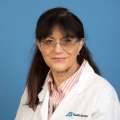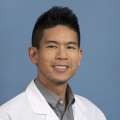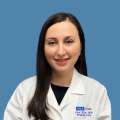Photo: Infection with COVID-19 or vaccination against the virus both prompt the body to produce an immune response in the form of disease-fighting antibodies and virus-targeting T-cells.
Many people who get infected with continue to have symptoms for months or years afterward, even after the infection has cleared and viral tests come back negative. These lingering symptoms can include shortness of breath, coughing, headaches, brain fog, chest pain and others.
The condition varies depending on the patient, but collectively these symptoms are known as “post-COVID syndrome” or “long COVID.”
In December 2020, the National Institute of Allergy and Infectious Diseases (NIAID) - the institute headed by Dr. Anthony Fauci - convened a two-day workshop for health care professionals to share what they were seeing among patients with long COVID symptoms.
“The conclusion was, you need a strong multidisciplinary team to tackle this,” said Nisha Viswanathan, MD, a primary care physician and assistant professor in the David Geffen School of Medicine at UCLA. “It really shouldn’t just fall on a primary care doctor or one subspecialist to deal with this.”
Out of that conference, the idea for the UCLA Long COVID Program took hold. “We started as a loose collective, meeting once a month to talk about what we were seeing and what we would like to do for these patients,” Dr. Viswanathan said.
Since then, she said, the University of California has made the program a priority and dedicated resources to the initiative. Now, the group meets regularly to coordinate care for patients in the program.
The team includes program director Dr. Viswanathan; neurologist Elyse Singer, MD; pulmonologist Kristin Schwab, MD; cardiologist Jeff Hsu, MD; psychiatrist Helen Lavretsky, MD; infectious diseases specialist Oladunni Adeyiga, MD; and three more primary care physicians: Lara Kose, MD, William Pittman, MD and Daniel Puneky, MD.
"I ask patients which symptoms are the ones they really want to focus on to help get their quality of life back.”
Dr. Nisha Viswanathan
To qualify, a patient must be experiencing symptoms at least 12 weeks after recovering from the initial viral infection. After being referred to the program, patients first meet with one of the primary care providers for an assessment.
At that initial visit, doctor and patient work together to identify the patient’s goals and priorities and select the appropriate subspecialist to best address the most disruptive symptoms.
“We do a comprehensive evaluation of their symptoms – rarely is it tidily just pulmonology, or just neurology,” explained Dr. Viswanathan. “At the end of my first meeting, I ask patients which symptoms are the ones they really want to focus on to help get their quality of life back.”
Searching for answers
The causes of long COVID are still not well understood and may vary from patient to patient.
The virus itself may have caused organ damage that lingers after the infection is gone. Another possibility is that the immune system gets overactivated fighting off the infection, and begins attacking the person’s own body, a condition called autoimmunity.
Dr. Singer said that improvements in imaging and other detection technology are revealing new information about how viral infections affect the brain and nervous system.
“We’re finding virus in people who were sick, but we’re also finding autoimmunity,” she said. “Their bodies are pushing back against the virus, and that’s probably why they made it through the disease. But that inflammatory response may not turn itself off once you don’t need it anymore. And that in and of itself may cause some of the neurologic problems that we see.”
Part of the team’s role is to deeply understand the patient’s history to home in on the most likely cause. Sometimes the viral infection can aggravate a previously undiagnosed or untreated condition. Having a multidisciplinary team reviewing the medical history can help catch these red flags and consider appropriate treatment options.
For instance, Dr. Singer noted that COVID can exacerbate existing neurologic symptoms, such as memory loss, nerve pain or a “pins and needles” sensation called paresthesia, that were previously noticed by the patient, but had been mild enough that they were never fully investigated or treated. After COVID, these symptoms may become more frequent or unbearably severe.
The stress of being ill can worsen depression and anxiety to a critical degree. “Sometimes, it’s a continuation of uncontrolled psychiatric symptoms,” said Dr. Viswanathan. “We found that sometimes we work on that and they get so much better, and we haven’t done anything other than antidepressants and therapy.”
When patients are deprived of oxygen, as can happen with COVID, that can also damage the brain and lead to cognitive problems, Dr. Singer points out.
“These are patients who very possibly should have been in the hospital but weren’t, because the hospitals were filled to capacity,” she says. “Their pneumonia interfered with the ability to keep their oxygen levels up.”
Another problem is that some patients may have developed very tiny clots in their blood vessels, which affected the brain. Other times, a patient may have had a high fever with delirium and hallucinations, which can lead to neurologic or psychological aftereffects.
Treatment and recovery
Considering the patient’s full constellation of symptoms helps the team provide the best possible treatment. For instance, the Long COVID program now has a to improve patients’ lung function, which also addresses mental health issues by providing therapy in a joyful and social setting.
The doctors also recognize the importance of helping the patient emotionally cope with their lengthy recovery. They have created protocols for addressing fatigue, getting back to exercise, treating depression, and they meet regularly to discuss complex care management between subspecialists and primary care physicians. Furthermore, the group collaborates with researchers and other subspecialists to further education about the long COVID condition.
“Often patients had nothing wrong before they had COVID, and this is life-altering,” says Dr. Viswanathan. “A lot of times they need reassurance that everything that’s happening to them is normal and expected, and that things will get better over time.”
Learn more about the UCLA Long COVID Program and how post-COVID symptoms are treated.
Caroline Seydel is the author of this article.










